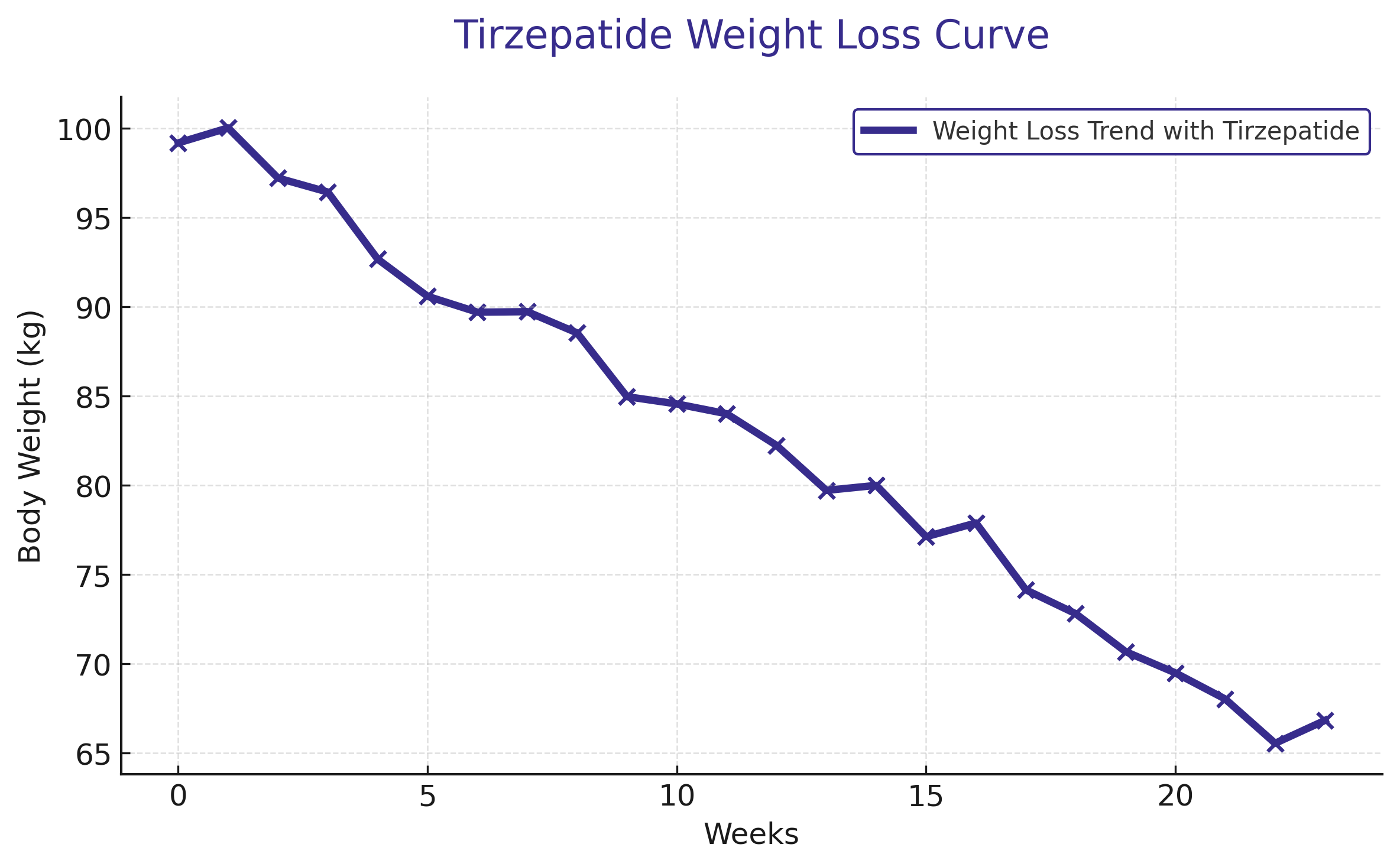Table of Contents
1. Introduction: What Is Tirzepatide?
2. Signs of Metabolic Imbalance and Weight Management Issues
3. How Tirzepatide Works
4. Key Health Benefits of Tirzepatide
5. Safe Usage and Dosage Guidelines
6. Possible Side Effects and Precautions
7. Frequently Asked Questions (FAQs)
8. Conclusion
1. Introduction: What Is Tirzepatide?
Tirzepatide is one of the most advanced peptide-based therapies developed to address metabolic disorders such as type 2 diabetes and obesity.
It acts as a dual agonist that targets both the GLP-1 (glucagon-like peptide-1) and GIP (glucose-dependent insulinotropic polypeptide) receptors.
This dual mechanism enhances insulin secretion, reduces glucagon levels, slows gastric emptying, and supports fat metabolism — providing comprehensive benefits for glucose control and weight reduction.
As obesity and metabolic syndrome continue to rise globally, Tirzepatide represents a major step forward in improving overall metabolic health and reducing associated disease risks.
2. Signs of Metabolic Imbalance and Weight Management Issues
Metabolic imbalance can manifest in several ways, often overlooked in daily life. Common warning signs include:
- Persistent weight gain, particularly around the abdomen, with limited response to diet or exercise.
- Elevated fasting glucose or HbA1c levels, indicating insulin resistance.
- High blood pressure, high cholesterol, or a combination of “three highs” that increase cardiovascular risk.
- Fatigue, brain fog, and slow recovery after physical activity.
- Signs of non-alcoholic fatty liver, sleep apnea, or reduced insulin sensitivity.
Identifying these early warning signs allows for timely intervention — including lifestyle changes and, when appropriate, medical treatments such as Tirzepatide.
3. How Tirzepatide Works
Tirzepatide functions through dual receptor activation, offering a synergistic effect:
- GLP-1 receptor activation: Enhances insulin secretion in response to meals, suppresses glucagon, slows gastric emptying, and promotes satiety — leading to reduced calorie intake.
- GIP receptor activation: Improves insulin sensitivity and enhances energy utilization, helping the body burn fat more efficiently.
Together, these actions improve blood sugar regulation, reduce body fat, and support overall metabolic homeostasis.
Tirzepatide is typically administered via subcutaneous injection, designed for sustained release and long-lasting therapeutic effects.
4. Key Health Benefits of Tirzepatide
Clinical studies have demonstrated a wide range of health benefits associated with Tirzepatide:
- Significant Weight Reduction: In Phase III clinical trials, participants using Tirzepatide experienced greater weight loss compared to placebo or other standard therapies.
- Improved Blood Sugar Control: Tirzepatide effectively lowers HbA1c levels and improves insulin sensitivity in patients with type 2 diabetes.
- Enhanced Cardiometabolic Health: Weight loss is often accompanied by reductions in blood pressure, LDL cholesterol, and triglycerides.
- Better Quality of Life: Improved metabolic health often leads to increased energy, self-confidence, and mobility.
- Potential Long-Term Benefits: By reducing fat accumulation and insulin resistance, Tirzepatide may help prevent chronic metabolic conditions such as NAFLD (non-alcoholic fatty liver disease) and metabolic syndrome.
In short, Tirzepatide offers a comprehensive approach to managing both weight and metabolic health — addressing multiple physiological targets simultaneously.
5. Safe Usage and Dosage Guidelines
- While dosage must always be tailored by a qualified healthcare professional, general principles include:
- Starting at a low dose to assess tolerance, then gradually increasing as directed.
- Regular monitoring of weight, BMI, fasting glucose, HbA1c, liver and kidney function.
- Combining Tirzepatide with balanced nutrition, exercise, and behavioral changes enhances long-term results.
- Close medical supervision is essential for individuals with liver, kidney, thyroid, or cardiovascular conditions.
- Long-term treatment should include evaluation of tolerance, effectiveness, and possible rebound effects after discontinuation.
6. Possible Side Effects and Precautions
Like any medication, Tirzepatide may cause side effects, especially at the beginning of treatment. Common and important considerations include:
- Gastrointestinal symptoms: Nausea, vomiting, diarrhea, constipation, or stomach discomfort — often temporary.
- Pancreatitis risk: Although rare, all GLP-1-related drugs require caution for individuals with a history of pancreatitis.
- Thyroid C-cell tumors: Observed in animal studies; human relevance is still being studied. Patients with thyroid nodules or cancer history should discuss risks with their provider.
- Hypoglycemia: Particularly when combined with insulin or other antidiabetic medications.
- Renal or gastrointestinal conditions: May require special dose adjustment or close monitoring.
- Pregnancy and breastfeeding: Not enough data; use only if clearly needed and under medical supervision.
Patients should always communicate with their healthcare provider about any side effects or unusual symptoms during treatment.
7. Frequently Asked Questions (FAQs)
Q1: What is Tirzepatide used for?
Tirzepatide is a dual-action injectable peptide designed to treat type 2 diabetes and support weight management in adults.
Q2: Is Tirzepatide effective for weight loss?
Yes. Clinical data show that Tirzepatide can result in substantial and sustained weight loss when combined with proper diet and exercise.
Q3: What should be monitored while using Tirzepatide?
Key indicators include body weight, BMI, fasting glucose, HbA1c, liver and kidney function, and gastrointestinal tolerance.
Q4: Is Tirzepatide safe?
It is generally well-tolerated, but possible risks include gastrointestinal discomfort, pancreatitis, thyroid C-cell changes, and hypoglycemia. Always use under medical supervision.
Q5: Who is a good candidate for Tirzepatide?
Adults with type 2 diabetes, obesity, or insulin resistance who have not achieved adequate results through lifestyle modification or other medications.
8. Conclusion
Tirzepatide marks a new era in the treatment of metabolic disorders — offering a dual-action mechanism that improves both glucose regulation and body composition.
For individuals struggling with obesity or type 2 diabetes, it provides a promising path toward better metabolic balance, improved quality of life, and long-term health.
However, it is not a one-size-fits-all solution. Safe and effective use requires professional guidance, individualized dosing, and a comprehensive lifestyle plan.
When combined with healthy habits, Tirzepatide can be a transformative tool for achieving sustainable metabolic wellness.
Post time: Nov-11-2025



